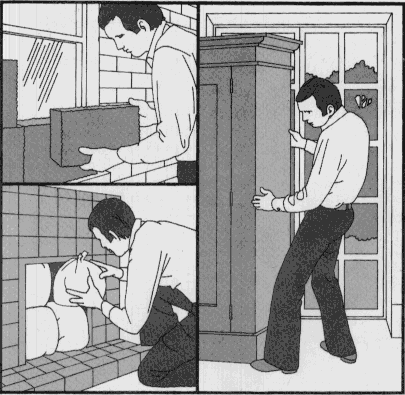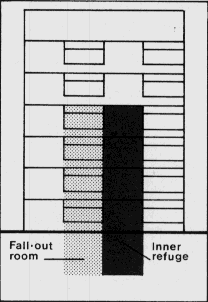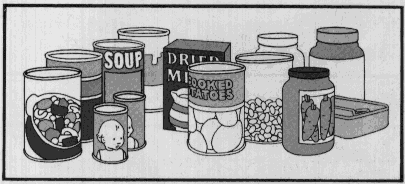| ANYONE REMEMBER THIS FROM THE EIGHTIES. | |||||||||||||||
|
|||||||||||||||
Ad_Forums-Top
Collapse
Announcement
Collapse
No announcement yet.
Protect and survive 1980 booklet
Collapse
X
-
Protect and survive 1980 booklet
FOR THE HONOUR OF GRAYSKULLTags: None
-
Re: Protect and survive 1980 booklet
 Planning for survival
Planning for survival
Stay at Home
Your own local authority will best be able to help you in war. If you move away - unless you have a place of your own to go to or intend to live with relatives - the authority in your new area will not help you with accommodation or food or other essentials. If you leave, your local authority may need to take your empty house for others to use.
So stay at home.
Plan a Fall-out Room and Inner Refuge
The first priority is to provide shelter within your home against radioactive fall-out. Your best protection is to make a fall-out room and build an inner refuge within it.
First, the Fall-out Room
Because of the threat of radiation you and your family may need to live in this room for fourteen days after an attack, almost without leaving it at all. So you must make it as safe as you can, and equip it for your survival. Choose the place furthest from the outside walls and from the roof, or which has the smallest amount of outside wall. The further you can get, within your home, from the radioactive dust that is on or around it, the safer you will be. Use the cellar or basement if there is one. Otherwise use a room, hall or passage on the ground floor.

Even the safest room in your home is not safe enough, however. You will need to block up windows in the room, and any other openings, and to make the outside walls thicker, and also to thicken the floor above you, to provide the strongest possible protection against the penetration of radiation. Thick, dense materials are the best, and bricks, concrete or building blocks, timber, boxes of earth, sand, books, and furniture might all be used.

 Flats
Flats
If you live in a block of flats there are other factors to consider. If the block is five stories high or more, do not shelter in the top two floors. Make arrangements now with your landlord for alternative shelter accommodation if you can, or with your neighbours on the lower floors, or with relatives or friends.
If your flat is in a block of four storeys or less, the basement or ground floor will give you the best protection. Central corridors on lower floors will provide good protection.
Still greater protection is necessary in the fall-out room, particularly for the first two days and nights after an attack, when the radiation dangers could be critical. To provide this you should build an inner refuge. This too should be thick-lined with dense materials to resist the radiation, and should be built away from the outside walls.
Here are some ideas:
1. Make a 'lean-to' with sloping doors taken from rooms above or strong boards rested against an inner wall. Prevent them from slipping by fixing a length of wood along the floor. Build further protection of bags or boxes of earth or sand - or books, or even clothing - on the slope of your refuge, and anchor these also against slipping. Partly close the two open ends with boxes of earth or sand, or heavy furnitureFOR THE HONOUR OF GRAYSKULL
-
Re: Protect and survive 1980 booklet
Now the Inner Refuge
Still greater protection is necessary in the fall-out room, particularly for the first two days and nights after an attack, when the radiation dangers could be critical. To provide this you should build an inner refuge. This too should be thick-lined with dense materials to resist the radiation, and should be built away from the outside walls.
Here are some ideas:
1. Make a 'lean-to' with sloping doors taken from rooms above or strong boards rested against an inner wall. Prevent them from slipping by fixing a length of wood along the floor. Build further protection of bags or boxes of earth or sand - or books, or even clothing - on the slope of your refuge, and anchor these also against slipping. Partly close the two open ends with boxes of earth or sand, or heavy furniture.

2. Use tables if they are large enough to provide you all with shelter. Surround them and cover them with heavy furniture filled with sand, earth, books or clothing.

3. Use the cupboard under the stairs if it is in your fall-out room. Put bags of earth or sand on the stairs and along the wall of the cupboard. If the stairs are on an outside wall, strengthen the wall outside in the same way to a height of six feet.

FOR THE HONOUR OF GRAYSKULL
Comment
-
Re: Protect and survive 1980 booklet
PLAN YOUR SURVIVAL KIT
Five essentials for survival in your Fall-out Room
1Drinking Water
You will need enough for the family for fourteen days. Each person should drink two pints a day - so for this you will need three and a half gallons each.
You should try to stock twice as much water as you are likely to need for drinking, so that you will have enough for washing. You are unlikely to be able to use the mains water supply after an attack - so provide your drinking water beforehand by filling bottles for use in the fall-out room. Store extra water in the bath, in basins and in other containers.
Seal or cover all you can. Anything that has fall-out dust on it will be contaminated and dangerous to drink or to eat. You cannot remove radiation from water by boiling it.

2Food
Stock enough food for fourteen days.
Choose foods which can be eaten cold, which keep fresh, and which are tinned or well wrapped. Keep your stocks in a closed cabinet or cupboard.
Provide variety. Stock sugar, jams or other sweet foods, cereals, biscuits, meats, vegetables, fruit and fruit juices. Children will need tinned or powdered milk, and babies their normal food as far as is possible. Eat perishable items first. Use your supplies sparingly.

3Portable Radio and Spare Batteries
Your radio will be your only link with the outside world. So take a spare one with you if you can. Keep any aerial pushed in. You will need to listen for instructions about what to do after the attack and while you remain in your fall-out room.

FOR THE HONOUR OF GRAYSKULL
Comment
-
Re: Protect and survive 1980 booklet
THIS DOCUMENTARY CAME WITH THE BOOKLET.
https://youtu.be/a-4KKYmyZ6IFOR THE HONOUR OF GRAYSKULL
Comment
-
Re: Protect and survive 1980 booklet
Tin Opener, Bottle Opener, Cutlery and Crockery

5Warm Clothing

And don't forget to take this booklet with you
These further items will also be useful in the Fall-out Room:
6. Bedding, sleeping bags
7. Portable stove and fuel, saucepans
8. Torches with spare bulbs and batteries, candles, matchesFOR THE HONOUR OF GRAYSKULL
Comment
-
Re: Protect and survive 1980 booklet
. Torches with spare bulbs and batteries, candles, matches 
9. Table and chairs
10. Toilet articles soap, toilet rolls, bucket and plastic bags (see Sanitation)
11. Changes of clothing
12. First aid Kit - with household medicines and prescribed medicines. And at least aspirins or similar tablets, adhesive dressings, cotton wool, bandages, disinfectant, ointment, including 'Vaseline'FOR THE HONOUR OF GRAYSKULL
Comment
-
Re: Protect and survive 1980 booklet
13. Box of dry sand, cloths or tissues for wiping plates and utensils 
14. Notebook and pencils for messages
15. Brushes, shovels and cleaning materials, rubber or plastic gloves, dustpan and brush
16. Toys and magazines FOR THE HONOUR OF GRAYSKULL
FOR THE HONOUR OF GRAYSKULL
Comment
-
Re: Protect and survive 1980 booklet
I think we still have our copy in one of the umpteen boxes in our loft. I think the idea was to distribute the booklet at a time of great crisis, when a nuclear exchange was likely, so I assume it had been written (and printed?) sometime prior to 1980, which matches with the 70s feel of the accompanying film. The government decided to make the booklet available generally, rather than wait for a crisis, though I can't remember if each household was sent one through the post or if they were for sale/collection in shops.
As well as making the booklet available, local meetings were organised where the film was screened and someone was there to give a talk and answer questions. We went to one at a school one evening. There were copies of Protect and Survive there in several piles on a table. A man from some government department did a talk and showed the film via a 16mm projector, then we could ask questions. BTW the narrator of the film is Patrick Allen, well known to cinema and TV audiences in the 60s and 70s.
Comment
-
Re: Protect and survive 1980 booklet
Protect and Survive was a public information series on civil defence produced by the British government during the late 1970s and early 1980s. It is intended to inform British citizens on how to protect themselves during a nuclear attack, and consists of a mixture of pamphlets, radio broadcasts, and public information films. The series had originally been intended for distribution only in the event of dire national emergency, but provoked such intense public interest that the pamphlets were authorised for general release.
Protect and Survive was formally published in May 1980, but had come to the public's attention before that via a series of articles in The Times newspaper in January 1980
This wave of interest had been preceded by numerous letters to The Times in December 1979 questioning what Civil Defence arrangements were in place in the UK.
This was then followed by a Times leader on 19 January 1980 which noted that:
"In Britain, a Home Office booklet "Protect and Survive" remains unavailable." Following this unexpected publicity for Protect and Survive, The Minister of State at the Home Office, Leon Brittan, responding on the subject in the House of Commons on 20 February 1980 said that:
...attention has been focused on the decision of the Home Office not to publish, in advance of an imminent attack, the pamphlet entitled "Protect and Survive". It is not a secret pamphlet, and there is no mystery about it. It has been available to all local authorities and chief police and fire officers and to those who have attended courses at the Home Defence College at Easingwold. It has been shown to interested Members of Parliament and to journalists. It has not been published, for the simple reason that it was produced for distribution at a time of grave international crisis when war seemed imminent, and it was calculated that it would have the greatest impact if distributed then.
Originally posted by staffslad View PostI think we still have our copy in one of the umpteen boxes in our loft. I think the idea was to distribute the booklet at a time of great crisis, when a nuclear exchange was likely, so I assume it had been written (and printed?) sometime prior to 1980, which matches with the 70s feel of the accompanying film. The government decided to make the booklet available generally, rather than wait for a crisis, though I can't remember if each household was sent one through the post or if they were for sale/collection in shops.
As well as making the booklet available, local meetings were organised where the film was screened and someone was there to give a talk and answer questions. We went to one at a school one evening. There were copies of Protect and Survive there in several piles on a table. A man from some government department did a talk and showed the film via a 16mm projector, then we could ask questions. BTW the narrator of the film is Patrick Allen, well known to cinema and TV audiences in the 60s and 70s.Last edited by darren; 11-07-2017, 22:07.FOR THE HONOUR OF GRAYSKULL
Comment
-
Re: Protect and survive 1980 booklet
Very interesting to hear about how Protect and Survive came to be made available. It is not quite clear to me, though, whether the booklet was going to be printed off in a time of crisis or if it had already been printed and copies were sitting in a warehouse awaiting distribution when an attack was thought likely.
Comment





Comment